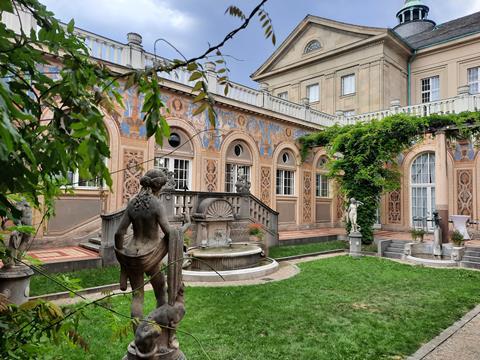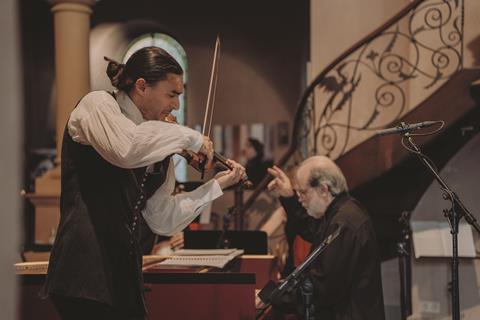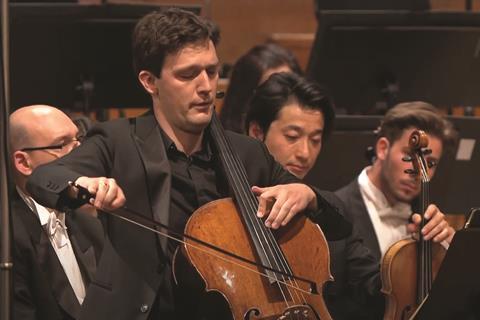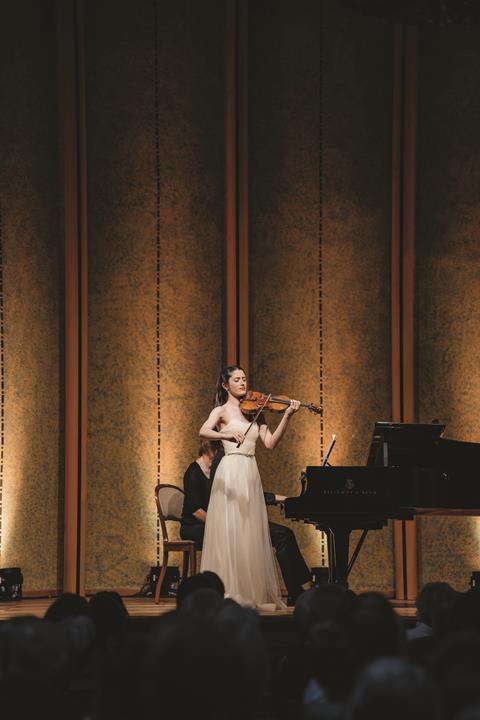A stay in northern Bavaria’s spa town of Bad Kissingen for the Kissinger Sommer festival proved to be a balm for the soul for Laurence Vittes

Discover more Featured Stories like this in The Strad Playing Hub.
Read more premium content for subscribers here
Amid a summer of wonderful European music festivals, Kissinger Sommer 2023 (16 June to 16 July) stood out for the depth and diversity of its programming, the excellence of its artists and the sheer beauty and elegance of the surroundings.
The German spa town of Bad Kissingen is situated in northern Bavaria. During the 19th century, it reached the height of its popularity as a summer wellness retreat – a magnet for tourists seeking the healing properties of its mineral springs. These days, the streets around the neo-Baroque Regentenbau, which houses several concert halls including the Max-Littmann-Saal, are filled with shops, restaurants and ice cream parlours. On approaching the Regentenbau from the rose garden across the street – with its thousands of bushes and more than 150 varieties of blooms, and its multimedia fountain with colourful water choreography – you are struck by the full grandeur of the building’s impact. You can take a relaxing stroll along the many paths that meander through the town that are interconnected by the walkway alongside the Franconian Saale river; and if you’re just looking for a bite to eat, there are pathways leading to the restaurants along Kurhausstrasse.
The soothing, healing and wellness comforts of the KissSalis Thermal Spa are to be found just up the hill. Bad Kissingen is perfectly paced for the pleasures and romance of classical music.

The festival has taken place every year since 1986, apart from 2020 when it was cancelled owing to the pandemic. Over the past ten years it has featured such string playing stars as violinists Ning Feng and Patricia Kopatchinskaja and cellist Sol Gabetta as artists-in-residence. The overall theme for this year’s festival was ‘La dolce vita’, centring on Italian musical journeys, and particularly one taken by Rossini, who spent four weeks in Bad Kissingen in the summer of 1856 on the advice of his doctor. The whole event was further divided into five subthemes, and I attended during the ‘Mi lagnerò tacendo’ (I will suffer in silence) one, which took place from Wednesday 28 June to Sunday 2 July and began with mezzo-soprano Giuseppina Bridelli giving a recital with pianist Matteo Pais in the Rossini-Saal which fans of Cecilia Bartoli would have adored and during which the enthusiastic audience took the opportunity to connect with friends.
Malov’s freely expressive, improvisatorial style had the Venetians on their toes
What of the strings component? As a cellist, I was blown away by the next two concerts. On 29 June, Maximilian Hornung played Haydn’s Cello Concerto no.2 in D major at the Max-Littmann-Saal. He was accompanied by the Bamberg Symphony, which had reduced its string section somewhat but still included three double basses and was conducted very enthusiastically (in two where possible) by Manfred Honeck. It is Haydn’s D major and not the First Concerto in C major that every cellist is asked to play in auditions, and Hornung and Honeck together challenged the notion that the first movement could be played too fast under the pressure of a live concert. It was brave and passionate, if not neat and immaculate. Hornung revealed a glimpse of the music’s softer heart in his short cadenzas, in contrast to the passages he had so boldly tried to conquer.

The concert had begun with a witty, open-hearted reading of Rossini’s overture to La gazza ladra which pushed the music, and the musicians, to full tilt. The orchestra was equal to every challenge, even more after the interval in an exhilarating performance of Schubert’s ‘Great’ Symphony in C major. Honeck had provided the bowings from his own set of parts and this ensured a strong, unified string force which the orchestra’s woodwind adorned and infused with exuberant pastel colours. All this, and the eloquent brass, was amplified by the enveloping acoustic warmth of the horseshoe-shaped hall.
The following night, purely by coincidence, another cellist – of a considerably different stripe – came to town. It was Sergey Malov playing two concertos each on the violin and the violoncello da spalla (an instrument of griffin-like provenance for which Bach may have written his Cello Suite no.6), replacing violinist Chouchane Siranossian at late notice, with Andrea Marcon’s Venice Baroque Orchestra. The concert they played in the responsive acoustics of the nearby Erlöserkirche could have been the soundtrack to an audiophile’s Baroque music dream. The programme was called ‘Duello di archi’ (String Duel), and there was a lot of that, especially when Malov switched over to the violin in a hair-raising Tartini Concerto in B flat major; his freely expressive, even more freely improvisatorial style had the Venetians constantly on their toes. The Vivaldi Concerto in G minor for two cellos RV531 (with Irene Liebau, the orchestra’s principal cellist) was a sumptuous delight, Malov bowing gracefully across his chest on the ‘da spalla’, as he refers to it. About 30 inches long and hanging from a strap around his neck, the instrument – built by Dmitry Badiarov – gave him the look of a troubadour and spoke with casual virtuosity and a seductive voice reminiscent at times of Bridelli’s mezzo-soprano. No wonder Malov styles himself ‘Spallenmann’ all over his social media.

There were many string-related riches I wished I could have stayed on for, or come earlier to. On 25 June, I would have been able to feast on concerts featuring a trio of violinist Francesca Dego, violist Milena Simović and cellist Laura van der Heijden; the Modigliani Quartet with violist Lise Berthaud and cellist Julian Steckel in Tchaikovsky’s Souvenir de Florence; and Anne-Sophie Mutter’s Virtuosi. Cellist Daniel Müller-Schott and pianist Annika Treutler played together on the day I left (Saturday 1 July), and later in July the Academy of St Martin in the Fields performed Tippett’s Fantasia concertante on a Theme by Corelli.
On 15 July, the young star violinist María Dueñas and pianist Evgeny Sinaiski performed a recital. Although the streets and hotels of Bad Kissingen have many fine and friendly restaurants, it could be a challenge to find a place to eat after the concerts. One of the best for almost any time was the Ristorante da Vito am Rosengarten. It is ideal for people-watching with its view of the Regentenbau and the rose garden. More subtle, more gratifying, was the Weinstube Rebstock opposite the Hotel Weisses Haus, reached through a discreetly hidden passageway and open for only a few days each week. It was there that I met the town’s music critic and Kissinger Sommer’s cultural editor Thomas Ahnert, who warmly recalled the halcyon days when the festival first took flight. A friend from Los Angeles told me he had attended all but the first two editions. I was not surprised. During my stay at Bad Kissingen for Kissinger Sommer, la dolce vita could not have been sweeter.
Read: Postcard from Kerteminde: Chamber Music at Lundsgaard
Read: ‘Keeping the accompanist on his toes’ - Postcard from Santander
Discover more Featured Stories like this in The Strad Playing Hub.
Read more premium content for subscribers here
The number one source for playing and teaching books, guides, CDs, calendars and back issues of the magazine.
In The Best of Technique you’ll discover the top playing tips of the world’s leading string players and teachers. It’s packed full of exercises for students, plus examples from the standard repertoire to show you how to integrate the technique into your playing.
The Strad’s Masterclass series brings together the finest string players with some of the greatest string works ever written. Always one of our most popular sections, Masterclass has been an invaluable aid to aspiring soloists, chamber musicians and string teachers since the 1990s.
American collector David L. Fulton amassed one of the 20th century’s finest collections of stringed instruments. This year’s calendar pays tribute to some of these priceless treasures, including Yehudi Menuhin’s celebrated ‘Lord Wilton’ Guarneri, the Carlo Bergonzi once played by Fritz Kreisler, and four instruments by Antonio Stradivari.






































No comments yet